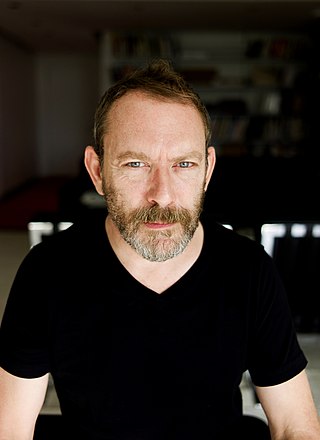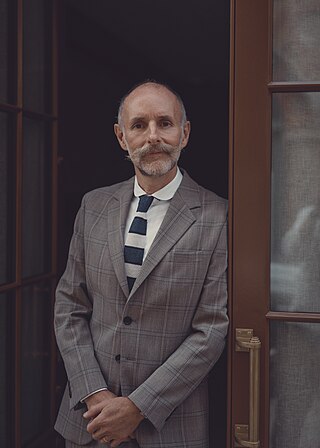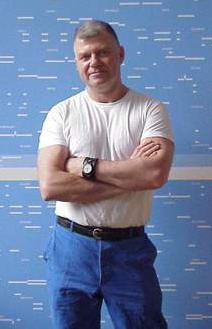
Dame Jocelyn Barbara Hepworth was an English artist and sculptor. Her work exemplifies Modernism and in particular modern sculpture. Along with artists such as Ben Nicholson and Naum Gabo, Hepworth was a leading figure in the colony of artists who resided in St Ives during the Second World War.

Sir Anthony Douglas Cragg is an Anglo-German sculptor, resident in Wuppertal, Germany since 1977.

Sir Anthony Alfred Caro was an English abstract sculptor whose work is characterised by assemblages of metal using 'found' and industrial objects. He began as a member of the modernist school, having worked with Henry Moore early in his career. He was lauded as the greatest British sculptor of his generation.
Karsten Schubert was a German art dealer and publisher working in London.

Fiona Rae is a Hong Kong-born British artist. She is one of the Young British Artists (YBAs) who rose to prominence in the 1990s. Throughout her career, she has been known for having a portfolio of work that includes elements of energy, and complexity. Her work is known for aiming at expanding the modern traditions of painting.

Liam Gillick is a British artist. In the 1990s he was one of the informal Young British Artists group; like many of them, he took a degree in fine art from Goldsmiths' College, in London. He was among the artists included in the Traffic exhibition at the Musée d'art contemporain de Bordeaux in Bordeaux in 1996, where Nicolas Bourriaud's concept of relationality was first proposed. Gillick lives in New York.

Glenn Brown is a British contemporary artist known for the use of appropriation in his paintings. Starting with reproductions from other artists' works, Glenn Brown transforms the appropriated image by changing its colour, position, orientation, height and width relationship, mood and/or size. Despite these changes, he has occasionally been accused of plagiarism.

Shirazeh Houshiary is an Iranian-born English sculptor, installation artist, and painter. She lives and works in London.

Dhruva Mistry is an Indian sculptor.
Lynn Russell Chadwick, was an English sculptor and artist. Much of his work is semi-abstract sculpture in bronze or steel. His work is in the collections of MoMA in New York, the Tate in London and the Centre Georges Pompidou in Paris.
Victor Arthur James Willing was a British painter, noted for his original nude studies. He was a friend and colleague of many notable artists, including Elisabeth Frink, Michael Andrews and Francis Bacon. He was married to Portuguese feminist artist Paula Rego.

Keith Milow is a British artist. He grew up in Baldock, Hertfordshire, and lived in New York City (1980–2002) and Amsterdam (2002–2014), now lives in London. He is an abstract sculptor, painter and printmaker. His work has been characterised as architectural, monumental, procedural, enigmatic and poetical.
Michael Sandle is a British sculptor and artist. His works include several public sculptures, many relating to themes of war, death, or destruction.
The year 2012 in art involved various significant events.

Ralph Brown was an English sculptor who came to national prominence in the late 1950s with his large-scale bronze Meat Porters, commissioned for Harlow New Town, Essex and is known for his sensual, figurative sculptures.
Kim Lim (1936–1997) was a Singaporean-British sculptor and printmaker of Chinese descent. She is most recognized for her abstract wooden and stone-carved sculptures that explore the relationship between art and nature, and works on paper that developed alongside her sculptural practice. Lim's attention to the minute details of curve, line and surface made her an exponent of minimalism.
Veronica Maudlyn Ryan is a Montserrat-born British sculptor. She moved to London with her parents when she was an infant and now lives between New York and Bristol. In December 2022, Ryan won the Turner Prize for her 'really poetic' work.

Cathie Pilkington is a London-based British sculptor represented by Karsten Schubert London. She studied at Edinburgh College of Art and the Royal College of Art, and was elected as a Royal Academician in 2014. She became professor of sculpture at the Royal Academy Schools in 2016.

Katherine Gili is a British sculptor. After completing her studies at Bath Academy of Art and St Martin's School of Art, Gili taught at a number of art schools; most notably St Martin's and Norwich between 1972 and 1985.
Rosie Leventon is a British visual artist whose practice encompasses sculpture, installation, land art, drawing and painting. She is known for making sculptural installations that reference current issues as well as the natural environment, prehistoric archaeology and vernacular architecture.













